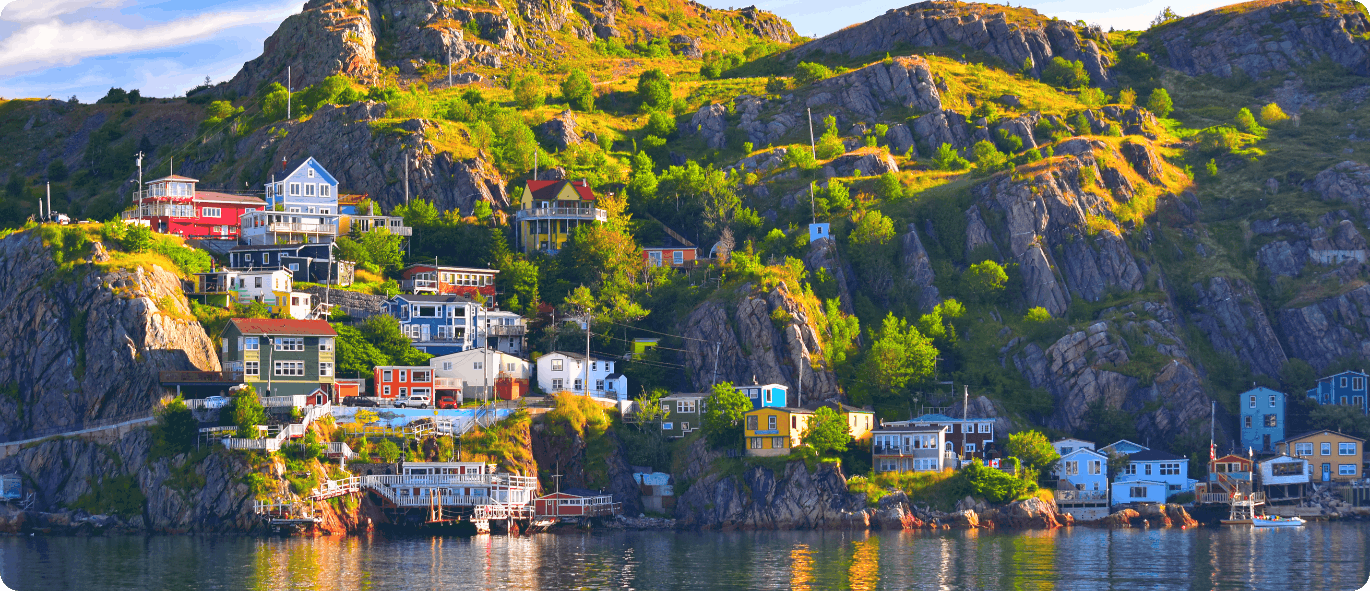Newfoundland and Labrador Immigration
As you conduct your research about Canadian immigration, you will find that each province and territory in Canada is unique in its own way and the province of Newfoundland and Labrador is no exception.
What is so special about Newfoundland and Labrador that attracts many immigrants to settle there after being issued their Permanent Resident Visa to Canada?
A Unique Province
Newfoundland and Labrador is the furthest east province in Canada, located on the country’s northeastern Atlantic coast.
On the map, Newfoundland and Labrador appears to be pretty far north, but the province is actually at the same basic latitude as Seattle, Washington, in the USA, and Paris, France.
The province is bordered by Quebec to the southwest; the Atlantic Ocean to the north and east; and is to the north of New Brunswick, Nova Scotia and Prince Edward Island.
This huge province has an area of 405,212 square kilometers and is slightly larger than Japan, a bit smaller than California in the USA, and double the size of the United Kingdom.
It should be noted that Newfoundland and Labrador is one unified province (not two provinces, as some people think, because of its name).
“Newfoundland” is the large island where over 90% of the province’s population of 521,542 (2019) lives, while “Labrador” refers to the part of the province that is on the Canadian mainland.
The province also has approximately 7,000 small islands.
Locals often refer to the province simply as “Newfoundland” for short (particularly since most people actually live on the island of Newfoundland.
Newfoundland was aptly named, as it probably seemed like a “new found land” to the famous Norse/Viking explorer, Leif Ericson, who landed in Newfoundland around 1000 C.E.
While Leif Ericson is often credited with being the first European to “discover” the New World, long before the famous voyages of the Italian explorers Christopher Columbus in 1492 and John Cabot in 1497, there were, of course, aboriginal people living in the area for approximately 8,000 years prior to his arrival in Newfoundland and Labrador.
If you would also like to discover what this unique province has to offer, you should consider further exploring Newfoundland and Labrador immigration!
Many immigrants choose to move to Newfoundland and Labrador after being granted their work visa to Canada because this scenic seaside province has many unique opportunities not found everywhere in Canada.
For example, the province is the home of “Iceberg Alley” where residents and visitors can view enormous 10,000-year-old icebergs float right past them just off the coast.
Icebergs are not the only interesting things to be seen offshore from Newfoundland and Labrador, as the province is also a great place to witness thousands of whales (22 different species) splash about in the spectacular salty surf.
Hikers and backpackers will also have a chance to enjoy the great outdoors as they trek along the most northern section of the famous Appalachian Trail (this is where the popular north-south transcontinental trail begins) or appreciate the breathtaking seaside views along East Coast Trail and Skerwink Trail.
Needless to say, photographers will be able to get a lot of great shots in this amazing province, including pictures of numerous picturesque lighthouses and some of the Earth’s oldest known rock formations, such as those found in Torngat Mountains National Park and the Tablelands at Gros Morne National Park.
In addition to whale-watching and bird-watching, nature lovers will be able to see black bears, caribou herds and lots of moose – over 120,000 moose on the loose throughout the province!

St. John’s – The Provincial Capital
The largest city in Newfoundland and Labrador is St. John’s (the provincial capital), which had a population of around 113,948 in 2017 and is located on the southeastern section of Newfoundland.
The next largest cities in the province include Conception Bay South, which had a population of 26,199 in 2016; Mount Perl, with 23,120 people (2016); Corner Brook (population 31,917, as of 2016); and Paradise, with 21,389 residents (2016).
St. John’s may be a medium-sized city, but you will discover that it has much to offer.
If you make Newfoundland and Labrador immigration and settle in St. John’s, you can enjoy the scenic serenity of Rennie’s River Trail located right in the middle of the city; capture a spectacular view of St. John’s and the Atlantic Ocean atop Signal Hill (be sure to visit the 400-year-old Cabot Tower) or from inside The Rooms (where you can enjoy a meal overlooking the city and the sea); explore the interesting geological history of the area at the Johnson Geo Centre; or spend a sunny day at Bowring Park.
There are several cultural and musical events in St. John’s throughout the year, such as the Newfoundland and Labrador Folk Festival which occurs each August.
George Street is merely one of several places in St. John’s where you’ll be able to find good restaurants, happening pubs and great venues for listening to live music.
The top business sectors where most people work in St. John’s include (2018): healthcare and social assistance; wholesale and retail trade; public administration; educational services; construction; professional, scientific and technical; accommodation and food services; information, culture and recreation; finance, insurance, real estate and rentals; transportation and warehousing; building and other support services; forestry, fishing, mining and oil; manufacturing; and utilities.
Foreign Workers Wanted
When planning for Canadian immigration, one key consideration is where to find jobs in Canada.
In Newfoundland and Labrador, major economic sectors include services (i.e., financial services, healthcare, etc.); the oil and gas industry (accounting for around 30% of provincial GDP); fishing; tourism; and agriculture.
If you are issued a work visa to Canada, you will have a legal right to live, work and study long-term in Newfoundland and Labrador and to apply for some of the thousands of Canada job openings forecast for the province over the next several years (according to “Outlook 2020”).
As a result of recent economic growth and an aging workforce that is retiring, there is now a shortage of skilled workers in the province.
Businesses in Newfoundland and Labrador are increasingly looking to Canadian immigration as a way to fill various Canada job openings, particularly in skilled trades due to several large construction projects underway (particularly in the energy sector), but in other occupations as well.
Thus, if you are thinking about applying for a work visa to Canada, you may discover new possibilities for a bright future through Newfoundland and Labrador immigration!
Immigrate to Canada for a Beautiful Future!
DISCLAIMER: This guide is not and shall not be considered as professional or expert advice.

